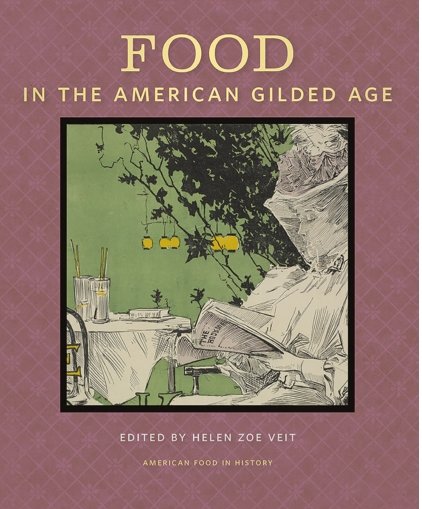
A look at the food of the late 1800s
In our world of fast food, microwave dinners and barbecues, it’s hard to imagine four-hour suppers where up to 40 courses of food were served to more than 400 guests. These not-so-intimate gatherings were all the rage during America’s Gilded Age, which ran roughly from 1870 to 1900.
In her book released last spring, “Food in the American Gilded Age,” MSU history professor Helen Zoe Veit pulled together an engrossing, and sometimes gross, collection of essays, recipes, advertisements and menus from that over-the-top era of food consumption.
One essay begins by detailing a menu from an Astor family gathering, unintelligible to the average person, which includes delectable items such as Cotelettes de Volailles Perigueux, Galantine de Poussins and Fraises Fondants. Of course, these delights were finished off with bon bons and petits fours.
The 400 guests were kept well-oiled with generous servings of wine and liqueurs between courses. The essay points out that the supper would begin “long after midnight amid dancing, an orchestra and a multitude of roses and palm trees.”
Veit said incredible suppers like these were held on the same street where “poor people were starving.”
“There was an enormous income gap and poor people were really suffering. You could see it in their bodies,” Veit said, referring to the visible lack of nutrition in the poor of that era.
Income disparity represented by food is just one of the important developments in our food culture. According to Veit, it was characteristic of the Gilded Age.
Other characteristics of the age were the ramp up in industrialization of food processing through developments in the canning and meat packing industries, a rise in food branding, transportation as well as a revolutionized approach to recipes.
Many of the early advertisements in the book are from Michigan State University’s Special Collections, which has an expansive number of historical cookbooks and food ephemera, donated by Haslett resident Shirley Sliker.
Veit said transportation, especially trains, helped bring food to people all over the country. This included imported food and food that could spoil easily, such as oysters.
“There is a myth that in the era people ate locally. It’s not true,” she said.
Refrigerated railroad cars were key in this. Refrigeration allowed a centralized meat processing industry to develop in Chicago and helped create massive fortunes for men like Gustavus Swift and Philip Armour.
The book states: “The changes in food distribution promised a sort of democracy of goods, in which even poor people would be able to buy plenty of fresh, luxurious food.”
Essays in the book underline how poor people in the gilded era in some ways ate the way we do today, on the go and with simple food that could be held in their hands and packed away in a pocket for lunch like the Yooper pasty favored by Cornwall miners.
The book also tells how male workers would often stop by the local saloon on the way to work to fortify themselves with a nickel beer.
And in the book, we find out there really was a “free lunch” — sort of.
During the Gilded Age, workers were enticed to visit saloons for a free lunch that according to a New York Times article from 1904 included “sliced onions and cucumbers, smothered with vinegar; sliced tomatoes, treated ditto; pickled beets, sauerkraut, potato salad, cold baked beans, liverwurst, bologna and smoked fish.”
Workers could access these salty, spiced and pickled delights by buying that “nickel beer.”
The “free lunch” would also provide ammunition to the growing temperance movement which saw the promotion as a way to get men to drink during the day.
Veit said the book also explores how in the late 19th century, the expansion of the print culture enabled a vast array of cookbooks and etiquette books to be published and readily available.
“Before these new recipe books, recipes were imprecise and usually contained no ingredient lists,” Veit said.
“Prior to cookbooks like the Boston Cooking School Cookbook, which was a national bestseller, people cooked from hand-written recipes or like poor people with no recipes at all,” Veit said.
The book also details the evolution of eating out and the rise of modern restaurants.
“The very best middle class restaurants were a step up from saloon food,” she said.
Early menus also show how the Gilded Age’s love of French became part and parcel of our food culture. The word “menu” itself is derived from a French word along with typical menu entries like “entrée.”
The book, the third in a series on American food published by the MSU Press, finishes up with a collection of recipes from the Golden Age. Many, like the classic potato salad, are still popular today.
Support City Pulse - Donate Today!
Comments
No comments on this item Please log in to comment by clicking here